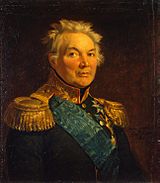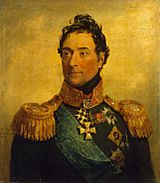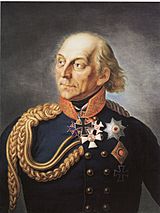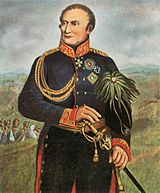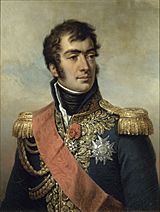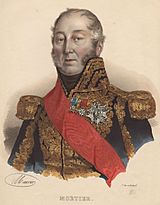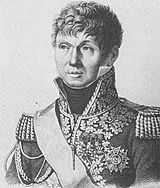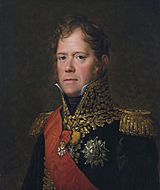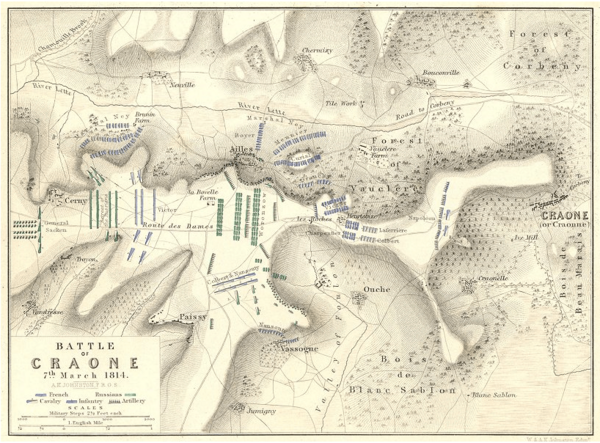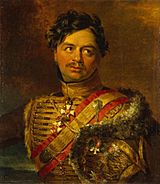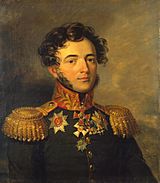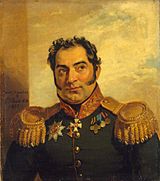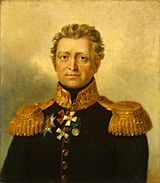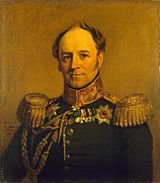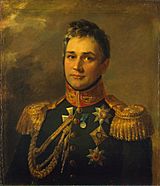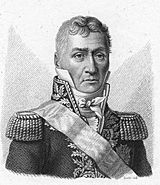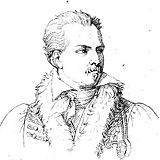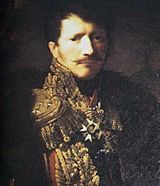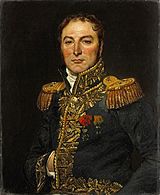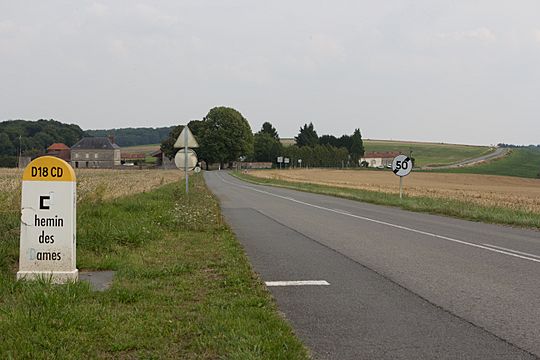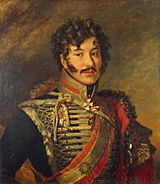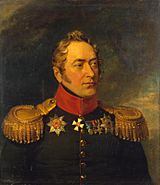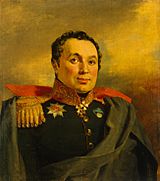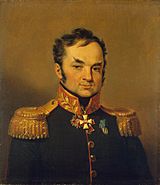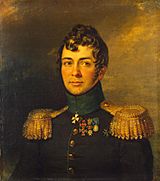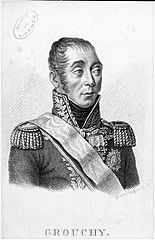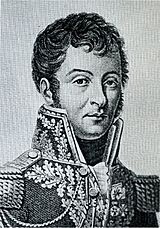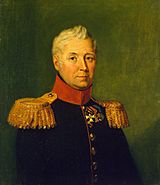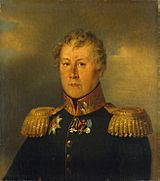Battle of Craonne facts for kids
Quick facts for kids Battle of Craonne |
|||||||
|---|---|---|---|---|---|---|---|
| Part of the Campaign of France of the Sixth Coalition | |||||||
 The battle of Craonne, by Theodore Jung |
|||||||
|
|||||||
| Belligerents | |||||||
| Commanders and leaders | |||||||
| Strength | |||||||
|
Craonne: |
Craonne: |
||||||
| Casualties and losses | |||||||
| 5,400–8,000 | 5,000 | ||||||
The Battle of Craonne took place on March 7, 1814. It was a major fight during the War of the Sixth Coalition. This war involved many European countries against Emperor Napoleon I of France. The battle happened near the town of Craonne in France.
In this battle, Napoleon's French army fought against a combined army. This Allied army included soldiers from Russia and Prussia. It was led by the Prussian Field Marshal Gebhard Leberecht von Blücher. The main part of Napoleon's army tried to push back about 22,000 Russian soldiers. These Russians were led by Mikhail Semyonovich Vorontsov. They were positioned on a high area called the Chemin des Dames plateau.
After a tough fight, Napoleon's forces managed to make the Russians retreat. However, the French army lost more soldiers than the Russians. During the battle, Blücher tried to attack Napoleon's side. But his plan failed because it wasn't well organized. The Battle of Craonne was part of a larger series of fights. The next big battle would be the Battle of Laon a few days later.
Craonne is located about 25 kilometers (15 miles) southeast of Laon. It is also about 90 kilometers (56 miles) northeast of Paris.
Background to the Battle
Armies on the Move
In early 1814, many countries were fighting against Napoleon. This was called the War of the Sixth Coalition. In February, a large Allied army was near Troyes, France. It had almost 150,000 soldiers. Napoleon had about half that number. The Allied commander, Karl Philipp, Prince of Schwarzenberg, decided to retreat. He thought he was outnumbered.
Another Allied commander, Blücher, wanted to keep fighting. He suggested his army split off and move north. Schwarzenberg agreed. Blücher's army, with 53,000 soldiers, then headed towards Paris. When Napoleon found out, he left some troops to watch Schwarzenberg. He then chased Blücher with 35,000 of his own men.
Chasing Blücher's Army
Blücher's army was trying to reach Paris. But two French Marshals, Auguste de Marmont and Édouard Mortier, blocked their way. They fought a battle on February 28. Blücher couldn't break through. On March 2, Blücher realized Napoleon was close behind him. He decided to retreat north across the Ourcq River.
Blücher knew that more Russian and Prussian troops were nearby. He hoped to join them soon. The town of Soissons surrendered early, which helped Blücher. It made it easier for his army to cross the Aisne River on March 3–4. By this time, Napoleon knew that a large Russian force had joined Blücher. This meant Blücher had at least 70,000 men. Napoleon had about 48,000.
Napoleon still hoped to reach Laon before Blücher. On March 5, Napoleon's cavalry captured Reims. They also seized a key stone bridge at Berry-au-Bac. This bridge was important for moving troops north. Napoleon's soldiers crossed the bridge and took positions. Meanwhile, Marmont and Mortier tried to capture Soissons again. They were pushed back by the Russian soldiers there.
Allied Generals in Command
Blücher planned for Vorontsov to defend a ridge called Chemin des Dames. Other Allied forces would support him. Blücher also planned a surprise attack on Napoleon's right side. This attack would involve a large cavalry force. But the plan had problems. The cavalry commander, Wintzingerode, found his troops were not ready. He decided to wait until morning to start his march.
French Generals in Command
The Battle of Craonne
Morning of March 6
On the evening of March 6, French soldiers captured Vauclair Abbey from the Russians. They also fought for Heurtebise Farm several times. But the Russian defenders held onto it. The French Old Guard took part of the Chemin des Dames ridge. French troops were spread out in the area.
Blücher's plan was for Vorontsov to hold the Chemin des Dames ridge. Other Allied troops would be in support. Meanwhile, a large cavalry force would try to attack Napoleon's army from behind. This cavalry was supposed to start marching early. But they were not ready, so they waited until daybreak.
Battle Plans for March 7
The Chemin des Dames is a long ridge. It runs east from the Soissons-Laon road. It is about 120 meters (400 feet) high. The ridge is narrow in some places. It has steep sides, especially on the north. This made it a strong defensive position for the Russians.
At 8:00 AM on March 7, Vorontsov arranged his Russian troops. They were in three lines, facing east. The first line was about 2.4 kilometers (1.5 miles) long. It was west of Heurtebise Farm. Russian light infantry held Heurtebise Farm itself. Cavalry and Cossacks were on the right side. Skirmishers (soldiers who fight in small groups) held the village of Ailles on the left.
Vorontsov had about 16,300 infantry, 1,000 regular cavalry, and 1,000 Cossacks. He also had 96 cannons. Another 4,000 cavalry were nearby. Napoleon had about 23,573 infantry and 6,350 cavalry. He also had 102 cannons. Napoleon planned a direct attack on the Russian lines. He would also send troops to attack the Russian sides.
Russian Generals in the Battle
French Generals in the Battle
The Fighting on March 7
At 9:00 AM, French cannons began firing. The Russian cannons fired back. But the distance was too great for much damage. Marshal Michel Ney attacked early, without waiting for orders. His troops were stopped by Russian cannons. Heurtebise Farm caught fire and was abandoned around 11:00 AM.
A French general, Claude Perrin Victor, was wounded early in the battle. Another general, Krasovsky, was also wounded. French troops captured the Marion Woods. But the Russian cannons were very effective. Napoleon's new soldiers, who had only been in the army for 20 days, were not very good at shooting.
Around 1:00 PM, the Russians almost pushed the French off the ridge. But French artillery stopped their attack. Napoleon ordered cavalry to charge. French dragoons attacked a Russian cannon battery. They cut down the gunners. But the dragoons were forced to retreat. Their commanders were wounded.
By 1:45 PM, French Guard cavalry charged the main Russian cannons. They reached the guns but couldn't break the Russian soldiers. These soldiers were formed in squares, which are strong defensive formations. The French cavalry had to pull back.
Meanwhile, more French divisions arrived. They captured the Quatre Heures Woods. They also started pushing back the Russian right side. The Allied plan to attack Napoleon's side failed. The cavalry was delayed and couldn't get into position. Blücher realized his plan wouldn't work. He ordered his generals to retreat.
At 2:30 PM, Napoleon ordered a final big attack. Eighty-eight French cannons fired grapeshot (small metal balls) at the Russian soldiers. French infantry and cavalry pushed forward. The Russians slowly fell back. They retreated in good order, forming squares to protect themselves.
The Russians crossed the Ailette River. French cannons fired at them during the crossing. But the Russian army managed to get away safely. The French chase ended around 7:00 or 8:00 PM. The French army camped on the Chemin des Dames ridge.
Result of the Battle
The Battle of Craonne was a French victory. Napoleon's army held the battlefield at the end of the day. However, it was a costly victory. This is sometimes called a Pyrrhic victory. It means a victory that comes with such a high cost that it feels like a defeat.
The Russians lost about 5,000 soldiers. The French lost between 5,400 and 8,000 soldiers. Many generals on both sides were wounded or killed. On the Russian side, General-Major Lanskoy was killed. Several other generals were wounded. On the French side, Marshal Victor and Generals Grouchy and Laferrière were wounded.
Napoleon had hoped to quickly defeat the Russians and reach Laon. But the tough fight at Craonne slowed him down. Instead of cutting off Blücher, Napoleon had to chase him directly. If Blücher had used all his infantry, Napoleon might have lost the battle. Napoleon thought the Allied army was confused and running away. But this was not true. Napoleon's army would face another defeat soon after, at the Battle of Laon.
Russian and French General Casualties


